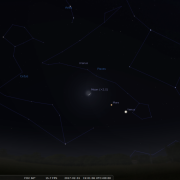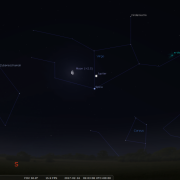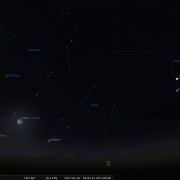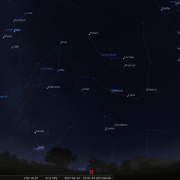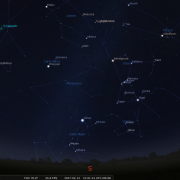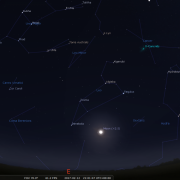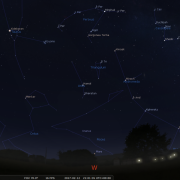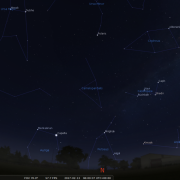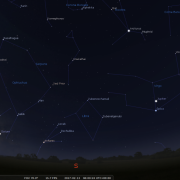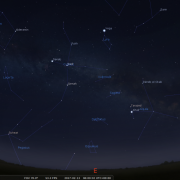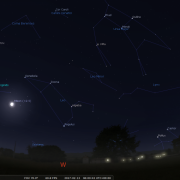Welcome to the WDAS monthly newsletter for February 2017: a digest of the month's latest contributions to our website. Below you'll find Society News, Sky Notes and In-Focus articles printed in full. There's also future events, and trailers for other articles which appear in full on the website - just a click away!
On the website you'll also be able to comment on articles, and if you'd like to play an editorial role in creating new content, just let us know!
Society News
 Prof Gibson is the Professor of Astrophysics director at the recently opened E.A Milne centre for Astrophysics in Hull. The centre was opened in 2015 and as Brad pointed out the centre is not named after the author of Winnie the Poo; AA Milne, but the distinguished astrophysicist and mathematician Edward Arthur Milne, who was born in Hull. Brad heads a research team who use supercomputer generated simulations to test, observational and theoretical predictions of galaxy formation and interactions, in particular spiral galaxies.
Prof Gibson is the Professor of Astrophysics director at the recently opened E.A Milne centre for Astrophysics in Hull. The centre was opened in 2015 and as Brad pointed out the centre is not named after the author of Winnie the Poo; AA Milne, but the distinguished astrophysicist and mathematician Edward Arthur Milne, who was born in Hull. Brad heads a research team who use supercomputer generated simulations to test, observational and theoretical predictions of galaxy formation and interactions, in particular spiral galaxies.
The supercomputer Prof Gibson and his colleagues use known as ‘Viper’, has 5500 cores. Brad explained how galaxy evolution simulation models are built by applying various factors; these are - initial conditions, laws of physics and known boundary conditions.
Prof Gibson demonstrated a simple simulation exercise by showing the dropped water block test. Here, 2 layers of water of different viscosity are initially separated. The initial condition is the elevated water, the ‘Physics’ ie gravity – is viscosity and the boundary conditions are set by the container itself. Once the segregation boundary is removed the liquids mix in a certain fashion. Early simulations were based on data accumulated from such tests. These in turn led to more complex modelling, for example dam break simulations and the spread of flu pandemics are all now tested using simulations.
Prof Gibson then talked in some detail on simulation factor parameters. The physics of galaxies, he suggested, began with William Parsons and the Leviathan at Birr Castle-Ireland, the great 72inch reflector completed in 1845. With this instrument the nebulous nature of spiral galaxies was first resolved as structure. As larger instruments entered service in the early 20th century, coupled with the use of astrophotography, an understanding of galactic structures began to take shape.
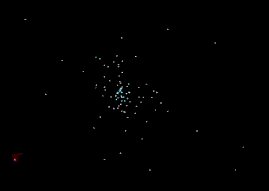
A really simple N-Body simulation: a
technique now being use to re-create the
Universe, primarily from the most basic rule
of gravity: that from double the distance it's
four times as weak.
Prof Gibson then turned to the role N-Body simulation and the inverse square law play, both crucial modelling factors. An N-Body simulation is a simulation of a dynamical system of particles, usually under the influence of physical forces such as gravity, they are widely used tools in astrophysics in understanding the evolution of the large-scale structures, like galaxies. N-Body simulations were first used in 1941, predating computers.
Most important for simulations is the role played the inverse-square law plays. This relates to any physical law where a specified physical quantity, or intensity, is inversely proportional to the square of the distance from the source of that physical quantity. When applied to Gravitation: the attraction force of two objects with mass, it is directly proportional to the product of their masses and inversely proportional to the square of their separation distance. Gravitation was first suggested in 1645 by Ismaël Bullialdus and expounded upon in 1666 by Robert Hooke. A third major component of the ‘Physics’ aspect of simulation modelling is Smoothed-particle hydrodynamics (SPH); a computational method used for simulating the dynamics of continuum media, such as fluid flows. Developed in the mid-seventies, it is especially useful for astrophysical problems.
Prof Gibson then briefly covered the ‘initial conditions factor’ which really stem from Cosmic Microwave Background data, he then played a clip of the universe in 30secs and showed a 3D funnel diagram of the Big Bang.
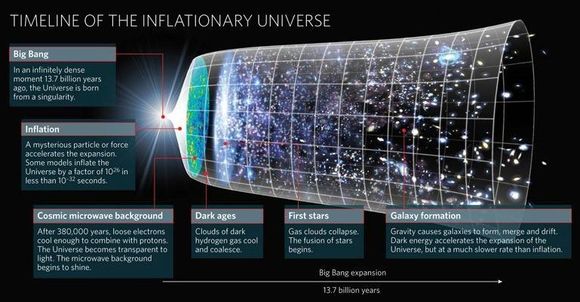
When all these factors are combined and applied in the correct percentages, (which for galaxy structure interactions, results in a ratio of the laws of fluid dynamics to the inverse square law of 15% to 85% respectively) and then run as simulations, the results yielded thick bulgy galaxies, obviously not what we observe. Some other refinement was required, one to inhibit material spiralling into the centre of the galaxy and piling up. The ‘refinement’ turned out to be supernova, an energy source which heats up the gases spiralling into the centre and pushes it outwards. In our galaxies 10 billion year history, upwards of 100 million supernova have provided an awful lot of energy to ensure this happens.
It is only the last 5 years that supercomputer simulations have started to closely match observed data and images. This has led analytical studies of simulations – where specific questions may be answered by inputting factors. Kinematics, chemistry, structure. For instance – where would you find rocky planets and possibly life? Well you would start by looking in the galactic habitable zone, where metals were more abundant but also away from supernova. Where do we find mineralogical building blocks – similar to those on earth. Simulations generated by super computer could actually point us in the general (or even more specific) direction.
In summary Prof Gibson suggested we should not be wary of simulations, they behave well at large scales, but improvement is required on smaller scales. Future refinements will factor in dust and magnetism influences giving more complex and detailed simulations. Certainly a field to watch in the future.
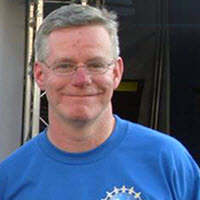 "So what are gravity waves", Prof Hendry asked? How did we detect them, and what can they tell us about the Universe. It took Einstein to figure out gravity’s true modus operandi. Gravity, Einstein showed, did not just make what goes up always come down. Gravity made the universe go round.
"So what are gravity waves", Prof Hendry asked? How did we detect them, and what can they tell us about the Universe. It took Einstein to figure out gravity’s true modus operandi. Gravity, Einstein showed, did not just make what goes up always come down. Gravity made the universe go round.
Ever since Newton discovered the laws of gravity uniting the earthly physics of falling apples with the cosmic dances of planets and stars, we have had some understanding on the nature of this force. But Newton’s laws didn’t explain how, and he refused to try. It was not until the early 20th century that a certain Albert Einstein really got to grips with gravity’s mysteries. Newton’s laws of gravity told us why the moon orbits around the Earth, Einstein told us how it knew to orbit. Far from travelling at its own pace through space, time and space were interwoven and played on the same stage as ‘spacetime’. Events that occur at the same time for one observer could occur at different times for another; this was the theory of special relativity.
But as Einstein worked on his theory of general relativity; he determined that massive objects distort space time so that it is curved. Space-time tells matter how to move and matter tells space-time how to curve.
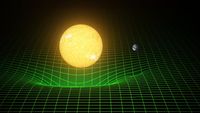 Imagine earth sitting in a warped and curved gravity well, with the moon following the earth within this space-time curved well. Think of space time as a grid on a stretched rubber sheet. The presence of mass then distorts space time. This warping equates to gravity.
Imagine earth sitting in a warped and curved gravity well, with the moon following the earth within this space-time curved well. Think of space time as a grid on a stretched rubber sheet. The presence of mass then distorts space time. This warping equates to gravity.
Einstein first predicted the existence of gravity waves – ripples in the curvature of space-time – caused or generated by certain gravity interactions that propagate as waves travelling at the speed of light. The strongest gravitational waves are produced by events such as colliding black holes, the collapse of stellar cores or supernova, coalescing neutron or white dwarf stars, the slightly wobbly rotation of neutron stars that are not perfect spheres, and the remnants of gravitational radiation created by the birth of the universe itself. However, as these waves spread out across the universe, those telltale signs of violent and cataclysmic processes become ever weaker, and extremely difficult to detect.
So how can such waves be detected, well, as Prof Hendry joked, it all done with smoke and mirrors, well mirrors and lasers really... LIGO (Laser Interferometer Gravitational wave Observatory). Two large observatories were built in the United States with the aim of detecting gravitational waves by laser interferometry, collecting data from 2002 until 2010. Nothing was detected. Other LIGO detectors were constructed in Sarstedt –Germany and Pisa in Italy. In 2008 work began on a major upgrade of the US facilities at Hanford, Washington and Livingstone, Louisiana, partly funded by the UK Science and Technology facilities council. The improved detectors; which ultimately will reach ten times the sensitivity of the original detectors, began operation in September 2015.
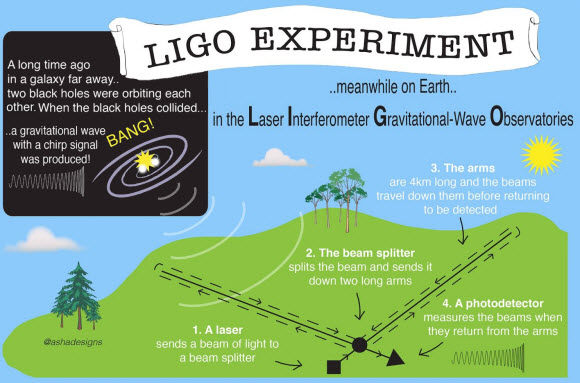
Gravitational waves squeeze and stretch space as they propagate. When the gravitational wave passes Earth it squeezes one arm of LIGO's light beam and stretches the other. The photodetector can measure the difference it causes in the light beams. As the gravitational wave oscillates, the squeezing and stretching also alternates. If an oscillation detected in LIGO's light beam matches the predicted chirp signal a gravity wave has been detected.
In 2014, there had been a false alarm when scientists announced that they had detected gravitational waves left over from the Big Bang using the Background Imaging of Cosmic Extragalactic Polarization (BICEP2) telescope in Antarctica. It is thought that such waves are embedded in the cosmic microwave background. However, further research revealed that their data was contaminated by dust in the line of sight.
On February 11th 2016 it was announced to the world that gravitational waves had been detected in September of 2015, very shortly after the advanced detectors were switched on. The initial source came from two merging black holes with solar masses of 29 and 36 respectively some 1.3 billion light years away. Energy equivalent to three solar masses was emitted as gravitational waves from the resultant 62 solar mass black hole. During the final fraction of a second of the merger, it released more than 50 times the power of all the stars in the observable universe combined. The observation also demonstrated, both the existence of binary stellar-mass black hole systems, and the fact that such mergers could occur within the current age of the universe
The detection was reported around the world as a remarkable accomplishment, making nearly a thousand front pages, efforts to directly prove the existence of such waves had been ongoing for over fifty years, and even Einstein doubted that they could ever be detected. The waves given off by the cataclysmic merger reached Earth as a ripple in space-time that changed the length of a 4-km LIGO arm by one thousandth of the width of a proton, proportionally equivalent to changing the distance to the nearest star outside the Solar System by one hair's width!
 If skies are reasonably clear on Feb 25th we have been invited to host a star party down at Boggle Hole Youth Hostel. The event commences at 19:00h until around 20:30h.
If skies are reasonably clear on Feb 25th we have been invited to host a star party down at Boggle Hole Youth Hostel. The event commences at 19:00h until around 20:30h.
Last year, the same event attracted large numbers ofthe public; indeed Keith and Mark were swamped at the two scopes deployed. We will discuss arrangements at the February meeting.
We have been invited to another ‘Star Night’ hosted by Eskdale School. This year’s event will take place on Wednesday 22nd of March, starting from 19:00h. The York University people will be on hand with the inflatable planetarium, and there will be food, soup, cakes, drinks etc available.
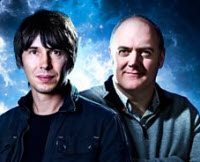 The event falls a week before this year’s BBC stargazing live, which apparently will be beamed live from Australia. The dates are March 28, 29 and 30th set to coincide with a no-moon period. We hope to have something planned ourselves, or in conjunction other parties. More on this in the March notes.
The event falls a week before this year’s BBC stargazing live, which apparently will be beamed live from Australia. The dates are March 28, 29 and 30th set to coincide with a no-moon period. We hope to have something planned ourselves, or in conjunction other parties. More on this in the March notes.
All being well Paul is set to return to Whitby in May. The venue will be the college main hall (Whitby college as was) May 9th is the date ‘inked in’ and we will be looking to start around 19:30h. No definite topic as yet, although Paul has suggested an updated talk on Voyager, to coincide with its 40th anniversary since launch.
There will be more in coming notes.
Cosmology Corner
Betelgeuse is a star constallation of Orion, which is well known for being very unstable and possibly exploding in a supanova at any point. It's a star that is often studied by astronomers, but before they can understand how a star goes supanova, they need to understand what the steady state of a star really is.
You need two forces that have to be in equilibrium: gravity which pulls inwards and tries to squeeze the matter together; and pressure (radioactive and gas pressure) which pushes outwards. While gravity wins, the star shrinks; but wile pressure wins the star diffuses into space.
In fact no star has a perfect equilibrium state, because they're highly dynamic objects. Even our sun is continually trying to balance the gravity and pressure, and therefore its radius can change; although for the moment the effect of that is so small, Earth doesn't really feel a thing and life is okay with it.
Betelgeuse is a very special star to astronomers because it's a pulsating star. These stars can vary very radically on very short timescales: years, months, days or even hours; depending on how pressure and gravity balance within the star.
So how does this star become unstable? If the gas pressure in some layer is too low to balance the gravity, the layer is compressed which will cause the temperature and pressure in that layer to increase. Eventually the pressure will overwhelm gravity and the star expands. All the energy that couldn't get through is suddenly released. Once this happens, the star starts to cool down, and the gas pressure drops to the point where gravity will take the lead.
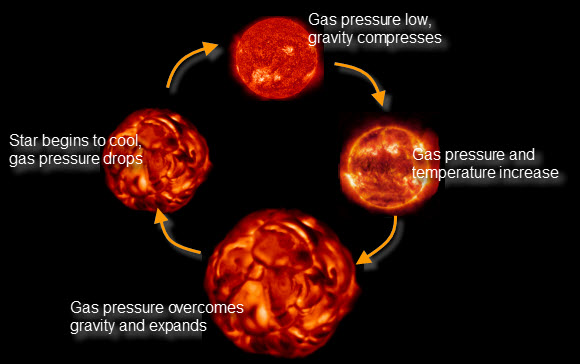
Betelgeuse's is classed as a "semi-regular variable star": its cycles vary in length over a long period. In its final phase it will explode as a supanova. It's very hard to predict exactly when this will happen, but when it does, it may be as bright as a full moon for a while, before almost totally disappearing and ruining the constellation of Orion!
 The video and material for this article was made by UK Astrophysicist Sebastian Pines, creator of the 'Astronomic' YouTube channel. You can support Seb's work creating videos that help to teach the world about astronomy by sponsoring a dollar or two per month via his Patreon page.
The video and material for this article was made by UK Astrophysicist Sebastian Pines, creator of the 'Astronomic' YouTube channel. You can support Seb's work creating videos that help to teach the world about astronomy by sponsoring a dollar or two per month via his Patreon page.
Sky Notes
In this month's Sky Notes:
Planetary Skylights

 Venus continues to dominate the evening sky – an unmistakeable beacon over in the SW. The crescent moon lies close to Venus on the first day of the month making for a pleasing visual treat, especially as Mars is also in the vicinity, indeed Venus and Mars are closest in the sky the following evening. Mars resembles an ochre star upper left of Venus.
Venus continues to dominate the evening sky – an unmistakeable beacon over in the SW. The crescent moon lies close to Venus on the first day of the month making for a pleasing visual treat, especially as Mars is also in the vicinity, indeed Venus and Mars are closest in the sky the following evening. Mars resembles an ochre star upper left of Venus.

 To counterbalance the two naked eye evening planets, two naked planets can also be found in the dawn sky. Conspicuous Jupiter is actually on view shortly before midnight at the start of the month and by 21:30h at the end, but for February the best observations of it would fall in the early morning hours. Look for it low in the east during the early part of late night, and towards the south for dawn.
To counterbalance the two naked eye evening planets, two naked planets can also be found in the dawn sky. Conspicuous Jupiter is actually on view shortly before midnight at the start of the month and by 21:30h at the end, but for February the best observations of it would fall in the early morning hours. Look for it low in the east during the early part of late night, and towards the south for dawn.
Telescopically, Jupiter always has something to offer, even for smaller apertures. Look for the banding on the disk and the attendant Galilean moons. Currently Jupiter lies above the bright star Spica in Virgo, view on the 15/16th when they are joined by a waning crescent Moon.
 Finally, Saturn is visible by 05:00h low to the SE. It resembles a prominent pearly star some distance to the left of ruddy hued Antares in Scorpius. Telescopically Saturn is a real joy to observe, with the rings well orientated. The crescent moon forms the apex of a triangle with Saturn and Antares on the 20th.
Finally, Saturn is visible by 05:00h low to the SE. It resembles a prominent pearly star some distance to the left of ruddy hued Antares in Scorpius. Telescopically Saturn is a real joy to observe, with the rings well orientated. The crescent moon forms the apex of a triangle with Saturn and Antares on the 20th.
Meteor Showers

There is just one minor meteor shower this month, the Alpha Aurigids.
The peak (if you can call it that) falls between Feb 6-9th. The Zenith Hourly Rate only reaches sporadic levels, barely half a dozen per hour, but if you do spot a meteor heading away from the direction of the zenith, (overhead) where the constellation of Auriga resides at this time of year, it is likely to be an Aurigid!
Comets
February could be a busy month with the possibility of a couple of periodic comets visible in binoculars.
Having spent the early part of January low in the SW in Capricornus Comet 45P is on the move making its closest approach to Earth on Feb 11th, coming within 7.7 million miles and brightening again to a predicted magnitude of +6. This is just on the edge of viewing with the naked eye. Look for it near the constellation Hercules just before dawn. See chart
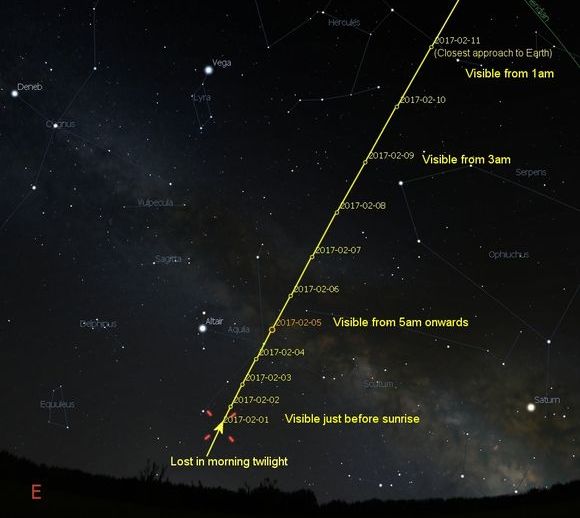
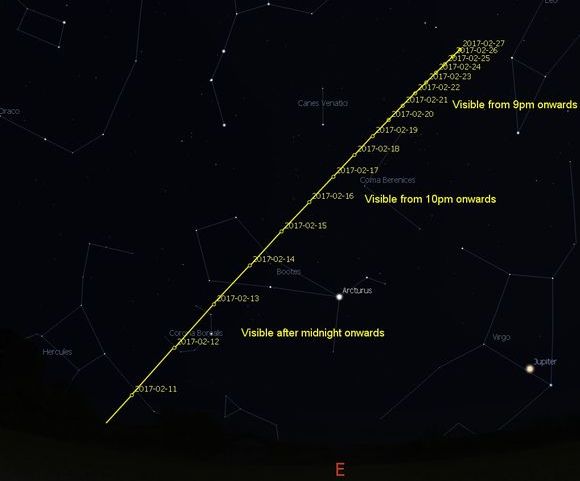
Finder Charts for Comet 45P Honda-Mrkos-Pajdusukova:
02-11-Feb-2017 (top) and 11-28-Feb-2017 (bottom)
The short periodic comet 2P Encke will once again returning. Discovered by Pierre Mechain in 1786, the comet has a period of 3.3 years and will be seen in the northern hemisphere this year, prior to perihelion in mid March. During February the comet brightens hopefully becoming a binocular object. It is though dropping rapidly into the northern dusk and will be lost by early March. The comet is the progenitor of the Taurid meteor shower.
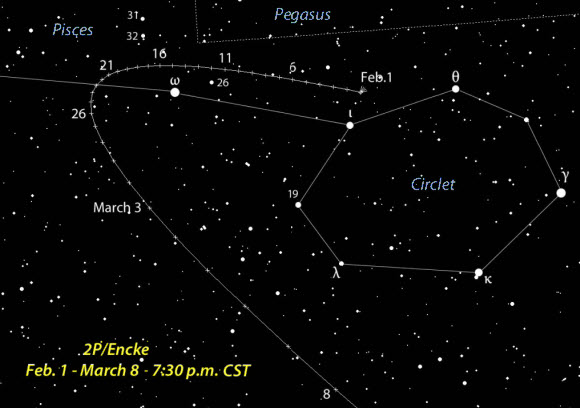
Finder Chart for Comet 2P Encke: 01-Feb-2017 to 08-Mar-2017
February 2017 Sky Charts
Click each image to see a full-size Sky Chart:
Additional Image Credits:
- Planets and Comets where not otherwise mentioned: NASA
- Sky Charts: Stellarium Software
Misc
There are just a few copies of Night Scenes 2017 unclaimed, so if you would like a copy it’s just £4 to society members, £5.50 otherwise.
Events
 Whitby School - Room H1.
Whitby School - Room H1.
In Members' monthly meetings we usually take a tour of the night sky for the coming month using the Planetarium program. Have talks and presentations on various topics of astronomy/space etc, and discuss future events etc. New members welcome.
 Observe the night sky with us at the Bruce Observatory, Whitby School
Observe the night sky with us at the Bruce Observatory, Whitby School
Observing Nights are held weather permitting: check for a relatively clear sky before leaving home. If in doubt, Mark can be reached on 07886069339
Please note the college drive gate is now operated via a electronic key code - so anyone wishing to attend must be at the car park at the top of the drive by 19:00hrs - unless an arrival time has been arranged with Mark/Keith.
 Observe the night sky with us at the Bruce Observatory, Whitby School
Observe the night sky with us at the Bruce Observatory, Whitby School
Observing Nights are held weather permitting: check for a relatively clear sky before leaving home. If in doubt, Mark can be reached on 07886069339
Please note the college drive gate is now operated via a electronic key code - so anyone wishing to attend must be at the car park at the top of the drive by 19:00hrs - unless an arrival time has been arranged with Mark/Keith.
 Observe the night sky with us at the Bruce Observatory, Whitby School
Observe the night sky with us at the Bruce Observatory, Whitby School
Observing Nights are held weather permitting: check for a relatively clear sky before leaving home. If in doubt, Mark can be reached on 07886069339
Please note the college drive gate is now operated via a electronic key code - so anyone wishing to attend must be at the car park at the top of the drive by 19:00hrs - unless an arrival time has been arranged with Mark/Keith.
 Whitby School - Room H1.
Whitby School - Room H1.
In Members' monthly meetings we usually take a tour of the night sky for the coming month using the Planetarium program. Have talks and presentations on various topics of astronomy/space etc, and discuss future events etc. New members welcome.


